![]()
![]()
![]()
Use LEFT and RIGHT arrow keys to navigate between flashcards;
Use UP and DOWN arrow keys to flip the card;
H to show hint;
A reads text to speech;
90 Cards in this Set
- Front
- Back
|
Where is pyruvate oxidatively decarboxylated to form acetyl CoA? |
In the mitochondrial matrix! |
|
|
What forms acetyl CoA from pyruvate? |
Pyruvate dehydrogenase complex |
|
|
Substrates are completely oxidized to form what? |
CO2 |
|
|
Electrons are removed from substrates and transferred to what? |
Carriers like NADH and FADH2 |
|
|
What do NADH and FADH2 do? |
They deliver electrons to the respiratory chain and eventually to O2 |
|
|
When O2 is NOT present, pyruvate is converted into what? |
Lactic acid or ethanol |
|
|
When O2 IS present, pyruvate is converted into what? |
acetyl CoA |
|
|
What is the link between glycolysis and the citric acid cycle? |
The IRREVERSIBLE conversion of pyruvate into acetyl CoA |
|
|
What is the pyruvate dehydrogenase complex? |
Large complex of 3 distinct enzymes, each with its own active site. |
|
|
What are the 3 enzymes that make up the pyruvate dehydrogenase complex? |
1. Pyruvate dehydrogenase component, E1 2. Dihydrolipoyl transacetylase, E2 3. Dihydrolipoyl dehydrogenase, E3 |
|
|
FAD can pick up what? |
2 electrons and 2 protons to form FADH2 |
|
|
What 3 enzymes serve as catalytic coenzymes of the pyruvate dehydrogenase complex? |
1. Thiamine pyrophosphate (TPP) 2. Lipoic acid 3. Flavin adenine dinucleotide (FAD) |
|
|
What 2 enzymes serve as stoichiometric coenzymes of the pyruvate dehydrogenase complex? |
1. CoA 2. NAD+ |
|
|
What do stoichiometric coenzymes do? |
They function as substrates |
|
|
What reaction does pyruvate dehydrogenase component catalyze? |
Oxidative decarboxylation of pyruvate |
|
|
What reaction does dihydrolipoyl transacetylase catalyze? |
Transfer of acetyl group to CoA |
|
|
What reaction does dihydrolipoyl dehydrogenase catalyze? |
Regeneration of the oxidized form of lipoamide |
|
|
In basic terms, what are the three steps to converting pyruvate into acetyl CoA? |
1. Decarboxylation 2. Oxidation 3. Transfer to CoA |
|
|
What happens in the inner membrane of mitochondria? |
Respiratory chain and ATP synthesis |
|
|
What is the net reaction for pyruvate dehydrogenase? |
Pyruvate + CoA + NAD+
--->
Acetyl CoA + CO2 + NADH + H+ |
|
|
What is the prosthetic group for pyruvate dehydrogenase component? |
TPP |
|
|
What is the prosthetic group for dihydrolipoyl transacetylase? |
Lipoamide |
|
|
What is the prosthetic group for dihydrolipoyl dehydrogenase? |
FAD |
|
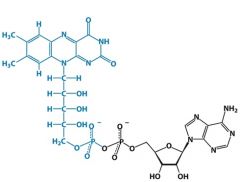
|
FAD |
|

|
TPP |
|
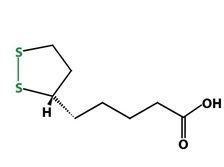
|
Lipoic acid |
|
|
Why is TPP good at attacing R2CO groups? |
TPP forms a stable carbanion |
|
|
How is pyruvate decarboxylated? What is formed? |
Carbanion of TPP + Pyruvate + 2H+ with pyruvate dehydrogenase component (E1)
forms
hydroxyethyl-TPP and CO2 |
|
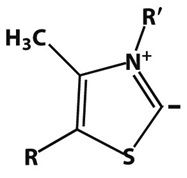
|
Carbanion of TPP |
|

|
Hydroxyethyl-TPP |
|
|
What is done to the hydroxyethyl-TPP? |
Via pyruvate dehydrogenase component (E1), H-TPP is oxidized while being simultaneously transferred to lipoamide (a derivative of lipoic acid) to form acetyllipoamide. |
|
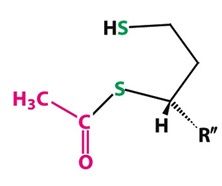
|
Acetyllipoamide |
|
|
CoA + Acetyllipoamide forms what? |
Acetyl CoA and dihydrolipoamide via dihydrolipoyl transacetylase (E2) |
|

|
Dihydrolipoamide |
|
|
Pyruvate dehydrogenase complex cannot complete another catalytic cycle until what is done? |
Until dihydrolipoamide is oxidized to lipoamide via dihydrolipoyl dehydrogenase (E3) |
|
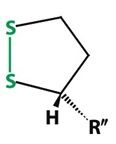
|
Lipoamide |
|
|
When the pyruvate dehydrogenase complex is reset, what is done electron wise? |
2 electrons are transferred to an FAD prosthetic group and then to NAD+ (so FAD and NADH remain) |
|
|
What does TPP do with its electrons in regards to pyruvate? |
TPP shares its electrons with pyruvate. |
|
|
Lipoamide has what side chain? |
Lysine side chain |
|
|
What is the role of lipoate (lipoic acid)? |
It serves as a place for the acetyl group from TPP which results in the formation of an energy-rich thioester bond. |
|
|
What is the role of FAD for pyruvate dehydrogenase complex? |
It takes electrons from dihydrolipoamide so lipoamide can be formed again. |
|
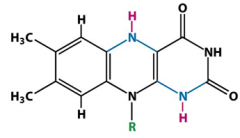
|
FADH2 |
|
|
FAD picks up 2 electrons and 2 protons from dihydrolipoamide to form what? |
FADH2 |
|
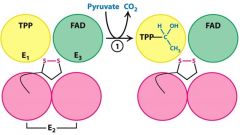
|
Pyruvate is decarboxylated to form hydroxyethyl-TPP via E1 |
|

|
Lipoamide arm of E2 movies into the active site of E1 |
|
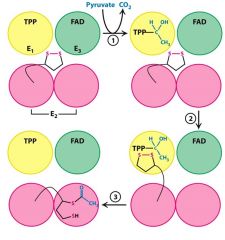
|
E1 catalyzes the transfer of the acetyl group to the lipoamide |
|
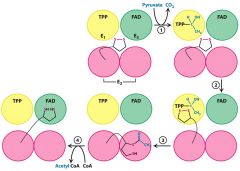
|
E2 catalyzes the transfer of the acetyl moiety to CoA to form acetyl CoA |
|

|
The oxidation of the dihydrolipoamide by FAD |
|
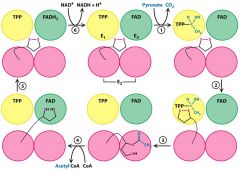
|
The final product, NADH, is produced with the reoxidation of FADH2 to FAD. |
|
|
TRUE OR FALSE: Pyruvate dehydrogenase reaction is reversible in animals. What does this mean? |
FALSE. It is irreversible. It means you can't make glucose from fats. |
|
|
What is the key means of regulating the pyruvate dehydrogenase complex? |
Phosphorylation! |
|
|
What does Pyruvate Dehydrogenase (PDH) kinase do? What does it need? |
It phosphorylates PDH and INACTIVATES it.
It needs ATP to do this! |
|
|
Deactivation of Pyruvate Dehydrogenase is reversed by what? |
By PDH phosphatase which REMOVES the phosphoryl group through hydrolysis and ACTIVATES PDH |
|
|
High NADH/NAD+, acetyl CoA/CoA, and ATP/ADP ratios stimulate what? |
Stimulate pyruvate dehydrogenase kinase which phosphorylates PDH and INACTIVATES it
|
|
|
Low NADH/NAD+, acetyl CoA/CoA, and ATP/ADP ratios stimulate what? |
Stimulate the INHIBITION of PDH kinase (so PDH won't get phosphorylated) |
|
|
What does a rise in Ca2+ concentration do? |
It activates PDH phosphatase which removes phosphoryl groups on PDH and ACTIVATES it. |
|
|
What is the function of the citric acid cycle? |
Harvesting of high-energy electrons from carbon fuels in the form of NADH and FADH2 |
|
|
What are the two parts of the citric acid cycle? |
One oxidizes carbon atoms to CO2
Other regenerates oxaloacetate |
|
|
What drives ATP synthesis? |
Electron-transport chain |
|
|
Oxaloacetate and Acetyl CoA combine to form what? What catalyzes the reaction? |
Combine to form Citryl CoA via citrate synthase |
|
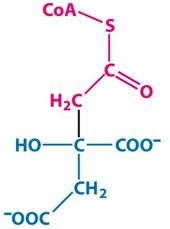
|
Citryl CoA |
|
|
Citryl CoA is converted into Citrate via what? What powers it? |
Hydrolysis of the high-energy thioester bond powers the synthesis of Citrate |
|
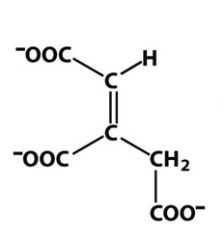
What is this and how is it formed? |
cis-aconitate is the intermediate between Citrate and Isocitrate.
It is formed via aconitase. |
|
|
Why is Citrate isomerized to Isocitrate? |
Citrate's hydroxyl group is not properly located for oxidative decarboxylations to occur |
|
|
How is Isocitrate converted into alpha-ketoglutarate? |
Oxidative decarboxylation of isocitrate to form oxalosuccinate which then converts to alpha-ketoglutarate via isocitrate dehydrogenase. |
|
|
Isocitrate to oxalosuccinate forms what? |
NADH |
|
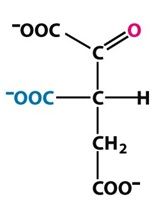
|
Oxalosuccinate |
|
|
How is alpha-ketoglutarate converted into Succinyl CoA? |
Oxidative decarboxylation via alpha-ketoglutarate dehydrogenase complex |
|
|
By the time Succinyl CoA is made, what have been released? |
2 CO2 molecules 2 NADH molecules |
|
|
The cleavage of the thioester bond of Succinyl CoA is coupled with what? |
The phosphorylation of a purine nucleoside diphosphate, usually ADP |
|
|
How is Succinyl CoA converted to Succinate? |
Succinyl CoA Synthase catalyzes Succinyl CoA + Pi + ADP to form Succinate + CoA + ATP |
|
|
What is the only step in the Citric Acid cycle that directly yield a compound with high phosphoryl-transfer potential? |
Succinyl CoA to Succinate via Succinyl CoA Synthase |
|
|
How is Succinate converted to Fumarate? What is produced? |
Oxidation with FAD and Succinate Dehydrogenase produces Fumarate and FADH2 |
|
|
How is Fumarate converted to Malate? |
Fumarate is hydrated to L-malate via Fumarase |
|
|
How is Malate converted to Oxaloacetate? What does this produce? |
Malate is oxidized with NAD+ to form oxaloacetate via malate dehydrogenase forming NADH |
|
|
What are the 4 oxidation reactions of the Citric Acid Cycle? |
1. Isocitrate to a-ketoglutarate 2. a-Ketoglutarate to Succinyl CoA 3. Succinate to Fumarate 4. Malate to Oxaloacetate |
|
|
In what 3 steps is NADH made? |
1. Isocitrate to a-ketoglutarate 2. a-ketoglutarate to Succinyl CoA 3. Malate to Oxaloacetate |
|
|
Although citrate is symmetric, the carboxyl groups at the ends are what? |
NOT equivalent meaning that citrate can only bind one way in the aconitase active cite |
|
|
Which step of the Citric Acid Cycle produces ATP? |
Succynl CoA to Succinate |
|
|
What are the primary control points of the Citric Acid Cycle? |
Regulating the allosteric enzymes isocitrate dehydrogenase and a-ketoglutarate dehydrogenase |
|
|
What stimulates isocitrate dehydrogenase? |
ADP because it signifies the need for more energy |
|
|
What two things inhibit isocitrate dehydrogenase? |
ATP and NADH because it signifies that energy is already present |
|
|
What 3 things inhibit a-ketoglutarate dehydrogenase? |
1. ATP 2. Succinyl CoA 3. NADH |
|
|
The inhibition of isocitrate dehydrogenase causes what? What does this lead to? |
The buildup of citrate which signals phosphofructokinase to halt glycolysis |
|
|
What are the 3 fates of Oxaloacetate? |
1. Glucose 2. Continuation in the citric acid cycle 3. Aspartate and then amino acids, purines, pyrimidines |
|
|
What are the 2 fates of Citrate? |
1. Fatty acids, sterols 2. Continuation in the citric acid cycle |
|
|
What are the two fates of a-ketoglutarate? |
1. Glutamate and then other amino acids and purines 2. Continuation in the citric acid cycle |
|
|
What are the two fates of Succinyl CoA? |
1. Porphyrins, heme, chlorophyll 2. Continuation in the citric acid cycle |
|
|
How is oxaloacetate replenished? |
Pyruvate is converted into oxaloacetate via pyruvate carboxylase |
|
|
What is the Glyoxylate Cycle? |
Cycle that bypasses the two decarboxylation steps of the citric acid cycle to convert acetyl CoA into glucose. ONLY IN PLANTS |

